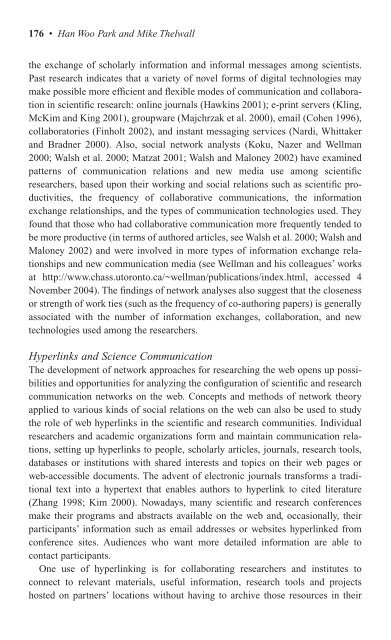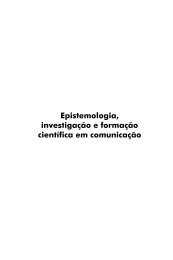Virtual Methods
Virtual Methods
Virtual Methods
You also want an ePaper? Increase the reach of your titles
YUMPU automatically turns print PDFs into web optimized ePapers that Google loves.
176 • Han Woo Park and Mike Thelwall<br />
the exchange of scholarly information and informal messages among scientists.<br />
Past research indicates that a variety of novel forms of digital technologies may<br />
make possible more efficient and flexible modes of communication and collaboration<br />
in scientific research: online journals (Hawkins 2001); e-print servers (Kling,<br />
McKim and King 2001), groupware (Majchrzak et al. 2000), email (Cohen 1996),<br />
collaboratories (Finholt 2002), and instant messaging services (Nardi, Whittaker<br />
and Bradner 2000). Also, social network analysts (Koku, Nazer and Wellman<br />
2000; Walsh et al. 2000; Matzat 2001; Walsh and Maloney 2002) have examined<br />
patterns of communication relations and new media use among scientific<br />
researchers, based upon their working and social relations such as scientific productivities,<br />
the frequency of collaborative communications, the information<br />
exchange relationships, and the types of communication technologies used. They<br />
found that those who had collaborative communication more frequently tended to<br />
be more productive (in terms of authored articles, see Walsh et al. 2000; Walsh and<br />
Maloney 2002) and were involved in more types of information exchange relationships<br />
and new communication media (see Wellman and his colleagues’ works<br />
at http://www.chass.utoronto.ca/~wellman/publications/index.html, accessed 4<br />
November 2004). The findings of network analyses also suggest that the closeness<br />
or strength of work ties (such as the frequency of co-authoring papers) is generally<br />
associated with the number of information exchanges, collaboration, and new<br />
technologies used among the researchers.<br />
Hyperlinks and Science Communication<br />
The development of network approaches for researching the web opens up possibilities<br />
and opportunities for analyzing the configuration of scientific and research<br />
communication networks on the web. Concepts and methods of network theory<br />
applied to various kinds of social relations on the web can also be used to study<br />
the role of web hyperlinks in the scientific and research communities. Individual<br />
researchers and academic organizations form and maintain communication relations,<br />
setting up hyperlinks to people, scholarly articles, journals, research tools,<br />
databases or institutions with shared interests and topics on their web pages or<br />
web-accessible documents. The advent of electronic journals transforms a traditional<br />
text into a hypertext that enables authors to hyperlink to cited literature<br />
(Zhang 1998; Kim 2000). Nowadays, many scientific and research conferences<br />
make their programs and abstracts available on the web and, occasionally, their<br />
participants’ information such as email addresses or websites hyperlinked from<br />
conference sites. Audiences who want more detailed information are able to<br />
contact participants.<br />
One use of hyperlinking is for collaborating researchers and institutes to<br />
connect to relevant materials, useful information, research tools and projects<br />
hosted on partners’ locations without having to archive those resources in their



